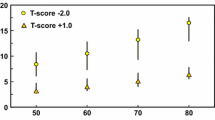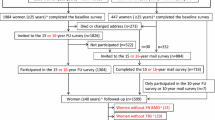Abstract
Summary
This is the first study to directly compare the original and recently updated versions of the trabecular bone score (TBS) algorithm. We confirmed improved performance of the new algorithm, especially among men.
Introduction
Lumbar spine trabecular bone score (TBS) predicts major osteoporotic fractures (MOFs) and hip fractures (HFs) independent of bone density. The original TBS algorithm (version 1; [TBS-v1]) was optimized for women of average body size. Limitations were identified when used in men or extremes of body mass index (BMI). The current study evaluates an updated TBS algorithm (version 2; [TBS-v2]) modified to address these issues.
Methods
From a registry with all DXA results for Manitoba, Canada, we identified 47,736 women and 4348 men age ≥ 40 with baseline spine DXA (GE Prodigy, 1999–2011). Spine TBS was measured using both TBS-v1 and TBS-v2 algorithms. Risk stratification for incident fractures identified from population-based data was assessed from area under the receiver operating characteristic curve (AUROC).
Results
With the TBS-v1 algorithm, average TBS for men was significantly lower than for women (p < 0.001) and showed significant inverse correlations with BMI (Pearson r−0.40 in men, −0.18 in women [both p < 0.001]). With the TBS-v2 algorithm, average values for men were slightly greater than for women (p < 0.001) and there were no significant correlations with BMI (Pearson r 0.01 in men, −0.01 in women [both p > 0.1]). During mean follow-up of 5 years in men, there were 214 incident MOFs and 47 HFs; during 6 years mean follow-up in women, there were 2895 incident MOFs and 694 HFs. Improvements in fracture prediction were seen with TBS-v2 in both men (change in AUROC for MOFs +0.021 [p = 0.17], HFs +0.046 [p = 0.04]) and women (change in AUROC for MOFs +0.012 [p < 0.001], HFs +0.020 [p < 0.001]).
Conclusion
The updated TBS algorithm is less affected by BMI, gives higher mean results for men than women consistent with their lower fracture risk, and improves fracture prediction in both men and women.
Similar content being viewed by others
References
Kanis JA, Melton LJ 3rd, Christiansen C, Johnston CC, Khaltaev N (1994) The diagnosis of osteoporosis. J Bone Miner Res 9(8):1137–1141
Kanis JA, McCloskey EV, Johansson H, Oden A, Melton LJ 3rd, Khaltaev N (2008) A reference standard for the description of osteoporosis. Bone 42(3):467–475
Looker AC, Wahner HW, Dunn WL, Calvo MS, Harris TB, Heyse SP, Johnston CC Jr, Lindsay R (1998) Updated data on proximal femur bone mineral levels of US adults. Osteoporos Int 8(5):468–489
Siris ES, Chen YT, Abbott TA, Barrett-Connor E, Miller PD, Wehren LE, Berger ML (2004) Bone mineral density thresholds for pharmacological intervention to prevent fractures. Arch Intern Med 164(10):1108–1112
Schuit SC, van der Klift M, Weel AE, de Laet CE, Burger H, Seeman E, Hofman A, Uitterlinden AG, van Leeuwen JP, Pols HA (2004) Fracture incidence and association with bone mineral density in elderly men and women: the Rotterdam Study. Bone 34(1):195–202
Stone KL, Seeley DG, Lui LY, Cauley JA, Ensrud K, Browner WS, Nevitt MC, Cummings SR (2003) BMD at multiple sites and risk of fracture of multiple types: long-term results from the Study of Osteoporotic Fractures. J Bone Miner Res 18(11):1947–1954
Cranney A, Jamal SA, Tsang JF, Josse RG, Leslie WD (2007) Low bone mineral density and fracture burden in postmenopausal women. CMAJ 177(6):575–580
Silva BC, Broy SB, Boutroy S, Schousboe JT, Shepherd JA, Leslie WD (2015) Fracture risk prediction by non-BMD DXA measures: the 2015 ISCD official positions part 2: trabecular bone score. J Clin Densitom 18(3):309–330
Harvey NC, Gluer CC, Binkley N, McCloskey EV, Brandi ML, Cooper C, Kendler D, Lamy O, Laslop A, Camargos BM, Reginster JY, Rizzoli R, Kanis JA (2015) Trabecular bone score (TBS) as a new complementary approach for osteoporosis evaluation in clinical practice. Bone 78:216–224
Leslie WD, Johansson H, Kanis JA, Lamy O, Oden A, McCloskey EV, Hans D (2014) Lumbar spine texture enhances 10-year fracture probability assessment. Osteoporos Int 25(9):2271–2277
McCloskey EV, Oden A, Harvey NC, Leslie WD, Hans D, Johansson H, Kanis JA (2015) Adjusting fracture probability by trabecular bone score. Calcif Tissue Int 96(6):500–509
Leslie WDLL, Morin SN, Majumdar SR, Winzenrieth R, Hans D (2014) Difference in spine TBS between men and women: real or technical? Osteoporos Int 25(Suppl 1):S25–S26
Aaron JE, Makins NB, Sagreiya K (1987) The microanatomy of trabecular bone loss in normal aging men and women. Clin Orthop Relat Res 215:260–271
Dalzell N, Kaptoge S, Morris N, Berthier A, Koller B, Braak L, van Rietbergen B, Reeve J (2009) Bone micro-architecture and determinants of strength in the radius and tibia: age-related changes in a population-based study of normal adults measured with high-resolution pQCT. Osteoporos Int 20(10):1683–1694
Khosla S, Riggs BL, Atkinson EJ, Oberg AL, McDaniel LJ, Holets M, Peterson JM, Melton LJ 3rd (2006) Effects of sex and age on bone microstructure at the ultradistal radius: a population-based noninvasive in vivo assessment. J Bone Miner Res 21(1):124–131
Hansen S, Shanbhogue V, Folkestad L, Nielsen MM, Brixen K (2014) Bone microarchitecture and estimated strength in 499 adult Danish women and men: a cross-sectional, population-based high-resolution peripheral quantitative computed tomographic study on peak bone structure. Calcif Tissue Int 94(3):269–281
Leslie WD, Metge C (2003) Establishing a regional bone density program: lessons from the Manitoba experience. J Clin Densitom 6(3):275–282
Leslie WD, Caetano PA, Macwilliam LR, Finlayson GS (2005) Construction and validation of a population-based bone densitometry database. J Clin Densitom 8(1):25–30
Lix LM, Azimaee M, Osman BA, Caetano P, Morin S, Metge C, Goltzman D, Kreiger N, Prior J, Leslie WD (2012) Osteoporosis-related fracture case definitions for population-based administrative data. BMC Public Health 12:301
DeLong ER, DeLong DM, Clarke-Pearson DL (1988) Comparing the areas under two or more correlated receiver operating characteristic curves: a nonparametric approach. Biometrics 44(3):837–845
McCloskey EV, Oden A, Harvey NC, Leslie WD, Hans D, Johansson H, Barkmann R, Boutroy S, Brown J, Chapurlat R, Elders PJ, Fujita Y, Gluer CC, Goltzman D, Iki M, Karlsson M, Kindmark A, Kotowicz M, Kurumatani N, Kwok T, Lamy O, Leung J, Lippuner K, Ljunggren O, Lorentzon M, Mellstrom D, Merlijn T, Oei L, Ohlsson C, Pasco JA, Rivadeneira F, Rosengren B, Sornay-Rendu E, Szulc P, Tamaki J, Kanis JA (2016) A meta-analysis of trabecular bone score in fracture risk prediction and its relationship to FRAX. J Bone Miner Res 31(5):940–948
Langsetmo L, Vo TN, Ensrud KE, Taylor BC, Cawthon PM, Schwartz AV, Bauer DC, Orwoll ES, Lane NE, Barrett-Connor E, Schousboe JT (2016) The association between trabecular bone score and lumbar spine volumetric BMD is attenuated among older men with high body mass index. J Bone Miner Res 31(10):1820–1826
Mazzetti GBC, Leslie W, Hans D, Langsetmo L, Hanley DA, Kovacs CS, Prior JC, Kaiser SM, Davison KS, Josse RG, Papaioannou A, Adachi J, Goltzman D, Morin SN (2017) Densitometer–specific differences in the correlation between body mass index and lumbar spine trabecular bone score. J Clin Densitom 20(2):233–238
Acknowledgements
The authors are indebted to Manitoba Health for the provision of data (HIPC 2012/2013 - 18). The results and conclusions are those of the authors, and no official endorsement by Manitoba Health is intended or should be inferred. This article has been reviewed and approved by the members of the Manitoba Bone Density Program Committee.
Author information
Authors and Affiliations
Corresponding author
Ethics declarations
Conflicts of interest
Hans: Co-ownership in the TBS patent; Stock options or royalties: Med-Imaps; Morin: Consultant to Amgen; Research Grants: Amgen and Merck; Schacter, Leslie, Majumdar, and Lisa Lix: None.
Funding
No external funding was required for this research.
Rights and permissions
About this article
Cite this article
Schacter, G.I., Leslie, W.D., Majumdar, S.R. et al. Clinical performance of an updated trabecular bone score (TBS) algorithm in men and women: the Manitoba BMD cohort. Osteoporos Int 28, 3199–3203 (2017). https://doi.org/10.1007/s00198-017-4166-1
Received:
Accepted:
Published:
Issue Date:
DOI: https://doi.org/10.1007/s00198-017-4166-1




